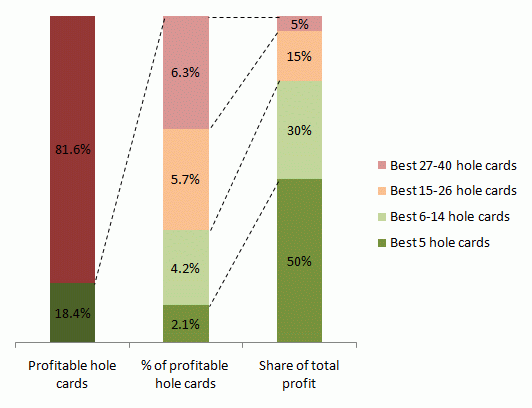Recommended Poker Room
The former Ongame poker site “Pokerroom” (now part of Bwin) had published an analysis of over 120 million starting hands on its website. The figures were derived from cash games (heads up, shorthanded, full ring tables). But the resulting conclusions can be but also be transferred to the early phases of tournaments (SnG, MTT, DoN).
We have taken a closer look at these statistics and were able to draw some very interesting conclusions:
- Only 40 of the 169 starting hands are profitable
- This represents only 18.4% of all the hole cards dealt
- Half of all profits are attributable to the five most profitable starting hands (AA, KK, QQ, JJ, and Ace-King suited)
Let’s look at these statements in detail.
Profitable Hole Cards in Texas Hold’em
There are a total of 52 x 51 = 2’652 possible starting hands. As the order in which the hole cards are dealt to you is not important (it does not matter if you get dealt ace-king or king-ace) and if we neglect the colors (it only plays a role whether the two hole cards are suited or not), then we are left with 169 different Texas Hold’em starting hands:
- 13 pocket pairs
- 78 suited hole cards (ace + 12 other cards, king + 11 other cards, queen + 10 other cards etc)
- 78 offsuited hole cards
Of these 169 possible combinations only 40 (23.7%) are profitable: on an average of just under 1 million hands played per combination of hole cards, the average profit was 0.01 BB or higher. But not all starting hands occur with the equal frequency: offsuited cards are dealt 3 times more frequently than suited cards, and pocket pairs are dealt 50% more often than suited cards. Since in particular high pocket pairs (pocket aces, pocket kings) and suited hole cards generate the profits, only 18.4% of all starting hands dealt are actually profitable.
The Four Groups of Profitable Hole Cards
For a better overview, we have formed four groups out of the profitable top 40 hole cards:
Top 5 hands (2.1% of all starting hands, 50% of profits): AA, KK, QQ, JJ and AKs
Top 6-14 hands (4.2% of all starting hands, 30% of profits): TT, 99, AQs, AJs, ATs, AK, AQ, KQs, KJs
Top 15-26 hands (5.7% of all starting hands, 15% of profits): 88, 77, A9s, A8s, AJ, AT, KTs, K9s, KQ, QJs, QTs, JTs
Top 27-40 hands (6.3% of all hands, 5% of profits): 66, 55, A7S-A3s, K8S, KJ, KT, Q9s, QJ, J9s, T9s
As you can see, half of all profits are generated by only 5 of the 169 starting hand combinations. And with a total of 14 of the 169 starting hands (6.3% of all hole cards dealt), 80% of all profits are made. So this should make it obvious that you should only play few hole cards in Texas Hold’em Cash Games. And in poker tournaments like Sit and Go’s, Double or Nothing or MTT, you should play even less starting hands.
For better understanding, we have put the above results in a graph which shows the profit of the combined groups of starting hands:

Hole Cards: Strategy for SnG, MTT and DoN
The strategy for the selection of starting hands for Sit and Go’s, Multi Table Tournaments and Double or Nothing SnG’s is derived from the above analysis. However, you must remember that in tournaments, chips won are worth less than chips lost. Accordingly, you should behave risk averse, thus avoiding risks such as coin-flip situations. This strategy is supported mathematically by the Independent Chip Model (ICM).
This means that Sit and Go poker players should play fewer hands than the average cash game player. In the early phase of Sit’n Gos, it is absolutely correct for SNG players to play very tight. It is enough if you just play hands from the best two groups of hole cards, the top 14 starting hands. If you are a multitabling grinder, playing many tables, you can reduce the complexity of the game further by playing even less hands. The top 10 hands in Texas Hold’em, which generate almost 70% of the profits, are AA-TT, AKs-AJs, AK and KQs.
Only in the middle and late stages of a tournament, when the blinds are high in relation to the remaining stack sizes, and if already several players were busted, you can (and should) play more hands. When the stack sizes are down to an effective size for 10-15 big blinds, the game becomes less complex. You will just have to decide whether you should go all-in pre-flop or if you should fold.
Therefore, our recommendation for Sit and Go’s, Double or Nothing, or to multi-table tournaments is to play very tight in the early – and only in the early phase – of the tournament.
Higher Profit (ROI) with a High Bonus
A very simple way to increase your ROI in tournaments is to clear a bonus. A bonus is equivalent to an average of about 50% rakeback. In tournaments, fees account to about 10%. This means that you can improve your ROI with a bonus by 5% points. Therefore, have a look at our exclusive poker bonus codes and offerings now!
888 Poker has one of the easiest to beat player pools. Avoid the sharks on PokerStars, play where the fishes are!
>>Beat the Fish at 888 Poker Now! Get $88 free! <<
 www.
www.

KJ is in two cats. the one in 6-14 should probably say KJs
Thank you very much cj
you were correct, the first KJ is the suited one. This error occurred while I translated my German article on the same subject of the best winning hands.
Umm… isn’t 40 hands out of 169 equal to 23.7% (as opposed to the 18.4% stated in the article)?
Hi Raph,
This is correct. But I’ve calculated the weighted percentages. For example, suited hands are stronger than offsuited hole cards. And suited cards are three times less often dealt than offsuited cards (eg on average you get three times AK offsuited for each time you get AKs). The same goes for pocket pairs, these are half as common as offsuited cards.
So that’s why the percentage is only 18.4% and not 23.7%. This means that the players made all of their profits with 40 of the 169 hands. Because these top hands are dealt less often, only 18.4% of all dealt hands to the average player will earn him a profit in the long run.
There are 2 KTs, one in each of the last two groups. The first should be KTs?
Hi Chweet
You are right, thanks for pointing to that error, which we now have corrected.
I play rebuy tournments…
Should I play all the 169 hands ?
Or Should I play only your selected hands?
Which group? How many hands?
In early stages.. before reentry time closes.
Haha, no, only play very few hands.
How many you want to play, depends on your strategy. But no more than 10-25% even in early stages. You just get beaten too often by better cards.
What about the fact that position play such an important factor I think it had like a Sten under the gun makes nowhere near as much money as it does on the button in fact under the gun is totally unprofitable in the long run for any poker player in the world from what I’ve read
Sure, position is another key factor. With enough time and data, one could make another analysis looking at hole cards profitability by position.
If you post something on internet at least learn the basic math. 5/169 is 2.9% No shit about weighted averages.
Hi Random
5/169 is 3.0% and not 2.9%.
But this article is about 120 million hands dealt out. And if you played a bit of poker you should know that it’s less likely to get a pair than two offsuit cards. For example, you are twice as likely to get AKo compared to AA (because for the second card, there are 4 and not only 3 other cards left, and because your first card could either be an ace or a king). Also, AKs is 3 times less likely than AKo. For that reason, the best 5 out of 169 starting hands combinations account only for 2.1% of all starting hands.
Thanks for reading.
So basically the same thing as here:
https://flopturnriver.com/poker-strategy/texas-holdem-expected-value-hand-charts-9-players-19149/
Top 10-20 hands has the biggest EV, therefor generate the biggest profit. The question should you play weaker hands in Late positions or play only strong hands all the time..I feel like I am loosing lot’s of time with weaker hands even though GTO suggest to play them. What’s your experience with that..
Seems to me that make sense to play only Aces and pairs..
Yes, the tables confirms what we said. Better position (button or close to the button) also improves EV slightly.